Minimally Invasive Markers of Stress and Production Parameters in Dairy Cows before and after the Installation of a Voluntary Milking System
Abstract
:Simple Summary
Abstract
1. Introduction
2. Materials and Methods
2.1. Selection of Cows
2.2. On-Farm Sampling
2.3. Laboratory Testing
2.4. Statistical Tests
3. Results
3.1. Production and Management Factors
3.2. Effect of Introducing a Voluntary Milking System on Salivary Cortisol in Dairy Cows
3.3. Effect of Introducing a Voluntary Milking System on Hair Cortisol in Dairy Cows
4. Discussion
4.1. Salivary Cortisol Analyses
4.2. Hair Cortisol Analyses
4.3. Milk Production Parameters
5. Conclusions
Supplementary Materials
Author Contributions
Funding
Acknowledgments
Conflicts of Interest
References
- Negrao, J.A.; Porcionato, M.A.; De Passille, A.M.; Rushen, J. Cortisol in saliva and plasma of cattle after ACTH administration and milking. J. Dairy Sci. 2004, 87, 1713–1718. [Google Scholar] [CrossRef]
- Verkerk, G.A.; Phipps, A.M.; Carragher, J.F.; Matthews, L.R.; Stelwagen, K. Characterization of milk cortisol concentrations as a measure of short-term stress responses in lactating dairy cows. Anim. Welf. 1998, 7, 77–86. [Google Scholar]
- del Rosario, G.-V.; Valdez, R.A.; Lemus-Ramirez, V.; Vázquez-Chagoyán, J.C.; Villa-Godoy, A.; Romano, M.C. Effects of adrenocorticotropic hormone challenge and age on hair cortisol concentrations in dairy cattle. Can. J. Vet. Res. 2011, 75, 216–221. [Google Scholar]
- Möstl, E.; Maggs, J.L.; Schrötter, G.; Besenfelder, U.; Palme, R. Measurement of cortisol metabolites in faeces of ruminants. Vet. Res. Commun. 2002, 26, 127–139. [Google Scholar] [CrossRef]
- Minton, J.E. Function of the hypothalamic-pituitary-adrenal axis and the sympathetic nervous system in models of acute stress in domestic farm animals. J. Anim. Sci. 1994, 72, 1891–1898. [Google Scholar] [CrossRef]
- Comin, A.; Peric, T.; Corazzin, M.; Veronesi, M.C.; Meloni, T.; Zufferli, V.; Cornacchia, G.; Prandi, A. Hair cortisol as a marker of hypothalamic-pituitary-adrenal axis activation in Friesian dairy cows clinically or physiologically compromised. Livest. Sci. 2013, 152, 36–41. [Google Scholar] [CrossRef]
- Burnett, T.A.; Madureira, A.M.L.; Silper, B.F.; Nadalin, A.; Tahmasbi, A.; Veira, D.M.; Cerri, R.L.A. Factors affecting hair cortisol concentrations in lactating dairy cows. J. Dairy Sci. 2014, 97, 7685–7690. [Google Scholar] [CrossRef]
- Hernandez, C.E.; Thierfelder, T.; Svennersten-Sjaunja, K.; Berg, C.; Orihuela, A.; Lidfors, L. Time lag between peak concentrations of plasma and salivary cortisol following a stressful procedure in dairy cattle. Acta Vet. Scand. 2014, 56, 61. [Google Scholar] [CrossRef] [Green Version]
- Tallo-Parra, O.; Lopez-Bejar, M.; Carbajal, A.; Monclús, L.; Manteca, X.; Devant, M. Acute ACTH-induced elevations of circulating cortisol do not affect hair cortisol concentrations in calves. Gen. Comp. Endocrinol. 2017, 240, 138–142. [Google Scholar] [CrossRef]
- Schwertl, M.; Auerswald, K.; Schnyder, H. Reconstruction of the isotopic history of animal diets by hair segmental analysis. Rapid Commun. Mass Spectrom. 2003, 17, 1312–1318. [Google Scholar] [CrossRef]
- Braun, U.; Michel, N.; Baumgartner, M.R.; Hässig, M.; Binz, T.M. Cortisol concentration of regrown hair and hair from a previously unshorn area in dairy cows. Res. Vet. Sci. 2017, 114, 412–415. [Google Scholar] [CrossRef] [PubMed]
- Uetake, K.; Morita, S.; Sakagami, N.; Yamamoto, K.; Hashimura, S.; Tanaka, T. Factors that determine cortisol level in hair of lactating dairy cows. J. Anim. Sci. 2018, 96, 515. [Google Scholar] [CrossRef]
- Burnett, T.A.; Madureira, A.M.L.; Silper, B.F.; Tahmasbi, A.; Nadalin, A.; Veira, D.M.; Cerri, R.L.A. Relationship of concentrations of cortisol in hair with health, biomarkers in blood, and reproductive status in dairy cows. J. Dairy Sci. 2015, 98, 4414–4426. [Google Scholar] [CrossRef] [Green Version]
- Fischer-Tenhagen, C.; Ladwig-Wiegard, M.; Heuwieser, W.; Thöne-Reineke, C. Is hair cortisol a potential indicator for stress caused by chronic lameness in dairy cows? J. Dairy Sci. 2018, 101, 5439–5443. [Google Scholar] [CrossRef] [Green Version]
- Peric, T.; Comin, A.; Corazzin, M.; Montillo, M.; Cappa, A.; Campanile, G.; Prandi, A. Hair cortisol concentrations in Holstein-Friesian and crossbreed F1 heifers. J. Dairy Sci. 2013, 96, 3023–3027. [Google Scholar] [CrossRef] [Green Version]
- Chacón, G.; Laita, S.G.-B.; del Portal, J.C.I.; Liesa, J.P. Validation of an EIA technique for the determination of salivary cortisol in cattle. Spanish J. Agric. Res. 2004, 45–52. [Google Scholar] [CrossRef] [Green Version]
- Lefcourt, A.M.; Bitman, J.; Kahl, S.; Wood, D.L. Circadian and ultradian rhythms of peripheral cortisol concentrations in lactating dairy cows. J. Dairy Sci. 1993, 76, 2607–2612. [Google Scholar] [CrossRef]
- Pagani, E.; Valle, E.; Barbero, R.; Osella, M.C.; Schiavone, A.; Prola, L. Effects of different housing systems on haematological profile, salivary cortisol concentration, and behavioural stress responses in calves of different ages. Large Anim. Rev. 2017, 23, 11–19. [Google Scholar]
- Gibbs, S.; Green, E.; Stedman, A.; Abayasekara, R.; Renshaw, D.; Fowkes, R. Salivary cortisol monitoring in sheep and cows: Evidence for acute activation of the hypothalamo-pituitary-adrenal (HPA) axis using two models of stress. In Proceedings of the Society for Endocrinology BES 2011, Birmingham, UK, 11–14 April 2011; Volume 25. [Google Scholar]
- Ketelaar-de Lauwere, C.C.; Hendriks, M.M.W.; Metz, J.H.M.; Schouten, W.G.P. Behaviour of dairy cows under free or forced cow traffic in a simulated automatic milking system environment. Appl. Anim. Behav. Sci. 1998, 56, 13–28. [Google Scholar] [CrossRef]
- Hopster, H.; Bruckmaier, R.M.; Van der Werf, J.T.N.; Korte, S.M.; Macuhova, J.; Korte-Bouws, G.; van Reenen, C.G. Stress Responses during Milking; Comparing Conventional and Automatic Milking in Primiparous Dairy Cows. J. Dairy Sci. 2002, 85, 3206–3216. [Google Scholar] [CrossRef]
- Gygax, L.; Neuffer, I.; Kaufmann, C.; Hauser, R.; Wechsler, B. Milk Cortisol Concentration in Automatic Milking Systems Compared with Auto-Tandem Milking Parlors. J. Dairy Sci. 2006, 89, 3447–3454. [Google Scholar] [CrossRef] [Green Version]
- Wenzel, C.; Schönreiter-Fischer, S.; Unshelm, J. Studies on step–kick behavior and stress of cows during milking in an automatic milking system. Livest. Prod. Sci. 2003, 83, 237–246. [Google Scholar] [CrossRef]
- Hagen, K.; Lexer, D.; Palme, R.; Troxler, J.; Waiblinger, S. Milking of Brown Swiss and Austrian Simmental cows in a herringbone parlour or an automatic milking unit. Appl. Anim. Behav. Sci. 2004, 88, 209–225. [Google Scholar] [CrossRef]
- Lexer, D.; Hagen, K.; Palme, R.; Troxler, J.; Waiblinger, S. Time budgets and adrenocortical activity of cows milked in a robot or a milking parlour: Interrelationships and influence of social rank. Anim. Welf. 2009, 18, 73–80. [Google Scholar]
- Weiss, D.; Helmreich, S.; Mostl, E.; Dzidic, A.; Bruckmaier, R.M. Coping capacity of dairy cows during the change from conventional to automatic milking1. J. Anim. Sci. 2004, 82, 563. [Google Scholar] [CrossRef]
- Whay, H.R.; Waterman, A.E.; Webster, A.J.F. Associations between locomotion, claw lesions andnociceptive threshold in dairy heifers during the peri-partum period. Vet. J. 1997, 154, 155–161. [Google Scholar] [CrossRef]
- Fowkes, R.C.; Moradi-Bidhendi, N.; Branceleone, V.; Zariwala, M.G.; Brady, D.; Jessop, D.S.; Perretti, M.; Renshaw, D. Annexin-A1 protein and its relationship to cortisol in human saliva. Psychoneuroendocrinology 2013, 38, 722–727. [Google Scholar] [CrossRef] [Green Version]
- Ferguson, J.D.; Galligan, D.T.; Thomsen, N. Principal Descriptors of Body Condition Score in Holstein Cows. J. Dairy Sci. 1994, 77, 2695–2703. [Google Scholar] [CrossRef]
- Vitali, A.; Segnalini, M.; Bertocchi, L.; Bernabucci, U.; Nardone, A.; Lacetera, N. Seasonal pattern of mortality and relationships between mortality and temperature-humidity index in dairy cows. J. Dairy Sci. 2009, 92, 3781–3790. [Google Scholar] [CrossRef] [Green Version]
- Rosca, M.; Forcada, Y.; Solcan, G.; Church, D.B.; Niessen, S.J.M. Screening diabetic cats for hypersomatotropism: Performance of an enzyme-linked immunosorbent assay for insulin-like growth factor 1. J. Feline Med. Surg. 2014, 16, 82–88. [Google Scholar] [CrossRef]
- Griffiths, B.E.; Grove White, D.; Oikonomou, G. A Cross-Sectional Study Into the Prevalence of Dairy Cattle Lameness and Associated Herd-Level Risk Factors in England and Wales. Front. Vet. Sci. 2018, 5, 65. [Google Scholar] [CrossRef] [PubMed] [Green Version]
- Hanks, J.; Kossaibati, M. Key Performance Indicators for the National Dairy Herd. Available online: https://www.nmr.co.uk/uploads/files/files/NMR500Herds-Report2017.pdf (accessed on 14 February 2020).
- Kovács, L.; Kézér, F.L.; Kulcsár-Huszenicza, M.; Ruff, F.; Szenci, O.; Jurkovich, V. Hypothalamic-pituitary-adrenal and cardiac autonomic responses to transrectal examination differ with behavioral reactivity in dairy cows. J. Dairy Sci. 2016, 99, 7444–7457. [Google Scholar] [CrossRef] [PubMed]
- Gómez, Y.; Bieler, R.; Hankele, A.K.; Zähner, M.; Savary, P.; Hillmann, E. Evaluation of visible eye white and maximum eye temperature as non-invasive indicators of stress in dairy cows. Appl. Anim. Behav. Sci. 2018, 198, 1–8. [Google Scholar] [CrossRef]
- Fisher, A.D.; Verkerk, G.A.; Morrow, C.J.; Matthews, L.R. The effects of feed restriction and lying deprivation on pituitary–adrenal axis regulation in lactating cows. Livest. Prod. Sci. 2002, 73, 255–263. [Google Scholar] [CrossRef]
- Ametaj, B.N.; Bradford, B.J.; Bobe, G.; Nafikov, R.A.; Lu, Y.; Young, J.W.; Beitz, D.C. Strong relationships between mediators of the acute phase response and fatty liver in dairy cows. Can. J. Anim. Sci. 2005, 85, 165–175. [Google Scholar] [CrossRef]
- Uetake, K.; Morita, S.; Sakagami, N.; Yamamoto, K.; Hashimura, S.; Tanaka, T. Hair cortisol levels of lactating dairy cows in cold- and warm-temperate regions in Japan. Anim. Sci. J. 2018, 89, 494–497. [Google Scholar] [CrossRef] [PubMed]
- Barker, Z.E.; Amory, J.R.; Wright, J.L.; Mason, S.A.; Blowey, R.W.; Green, L.E. Risk factors for increased rates of sole ulcers, white line disease, and digital dermatitis in dairy cattle from twenty-seven farms in England and Wales. J. Dairy Sci. 2009, 92, 1971–1978. [Google Scholar] [CrossRef]
- Mahendran, S.; Bell, N. Lameness in cattle 2. Managing claw health through appropriate trimming techniques. Practice 2015, 37, 231–242. [Google Scholar] [CrossRef]
- Bell, N.J.; Potterton, S.; Blowey, R.; Whay, H.R.; Huxley, J.N. Disinfectant footbathing agents for the control of bovine digital dermatitis in dairy cattle. Livestock 2014, 19, 6–13. [Google Scholar] [CrossRef]
- Klaas, I.C.; Rousing, T.; Fossing, C.; Hindhede, J.; Sørensen, J.T. Is lameness a welfare problem in dairy farms with automatic milking systems? Anim. Welf. 2003, 12, 599–603. [Google Scholar]
- Dearing, J.; Hillerton, J.E.; Poelarends, J.J.; Neijenhuis, F.; Sampimon, O.C.; Fossing, C. Effects of automatic milking on body condition score and fertility of dairy cows. In Automatic Milking; Wageningen Academic Publishers: Cambridge, MA, USA, 2004; p. 134. [Google Scholar]
- Melin, M.; Svennersten-Sjaunja, K.; Wiktorsson, H. Feeding patterns and performance of cows in controlled cow traffic in automatic milking systems. J. Dairy Sci. 2005, 88, 3913–3922. [Google Scholar] [CrossRef]
- Abeni, F.; Calamari, L.; Calza, F.; Speroni, M.; Bertoni, G.; Pirlo, G. Welfare assessment based on metabolic and endocrine aspects in primiparous cows milked in a parlor or with an automatic milking system. J. Dairy Sci. 2005, 88, 3542–3552. [Google Scholar] [CrossRef] [Green Version]
- Bach, A.; Devant, M.; Igleasias, C.; Ferrer, A. Forced traffic in automatic milking systems effectively reduces the need to get cows, but alters eating behavior and does not improve milk yield of dairy cattle. J. Dairy Sci. 2009, 92, 1272–1280. [Google Scholar] [CrossRef] [PubMed] [Green Version]
- Rousing, T.; Badsberg, J.H.; Klaas, I.C.; Hindhede, J.; Sørensen, J.T. The association between fetching for milking and dairy cows’ behaviour at milking, and avoidance of human approach—An on-farm study in herds with automatic milking systems. Livest. Sci. 2006, 101, 219–227. [Google Scholar] [CrossRef]
- Bach, A.; Iglesias, C.; Calsamiglia, S.; Devant, M. Effect of amount of concentrate offered in automatic milking systems on milking frequency, feeding behavior, and milk production of dairy cattle consuming high amounts of corn silage. J. Dairy Sci. 2007, 90, 5049–5055. [Google Scholar] [CrossRef] [Green Version]
- Borderas, T.F.; Fournier, A.; Rushen, J.; de Passillé, A.M.B. Effect of lameness on dairy cows’ visits to automatic milking systems. Can. J. Anim. Sci. 2008, 88, 1–8. [Google Scholar] [CrossRef]
- Munksgaard, L.; Rushen, J.; De Passillé, A.M.; Krohn, C.C. Forced versus free traffic in an automated milking system. Livest. Sci. 2011, 138, 244–250. [Google Scholar] [CrossRef]
- Dohmen, W.; Neijenhuis, F.; Hogeveen, H. Relationship between udder health and hygiene on farms with an automatic milking system. J. Dairy Sci. 2010, 93, 4019–4033. [Google Scholar] [CrossRef] [Green Version]
- Hovinen, M.; Pyörälä, S. Invited review: Udder health of dairy cows in automatic milking. J. Dairy Sci. 2011, 94, 547–562. [Google Scholar] [CrossRef]
- Klungel, G.H.; Slaghuis, B.A.; Hogeveen, H. The effect of the introduction of automatic milking systems on milk quality. J. Dairy Sci. 2000, 83, 1998–2003. [Google Scholar] [CrossRef]
- Abeni, F.; Degano, L.; Calza, F.; Giangiacomo, R.; Pirlo, G. Milk quality and automatic milking: Fat globule size, natural creaming, and lipolysis. J. Dairy Sci. 2005, 88, 3519–3529. [Google Scholar] [CrossRef]
- Helgren, J.M.; Reinemann, D.J. Survey of milk quality on US dairy farms utilizing automatic milking systems. Trans. ASABE 2006, 49, 551–556. [Google Scholar] [CrossRef]
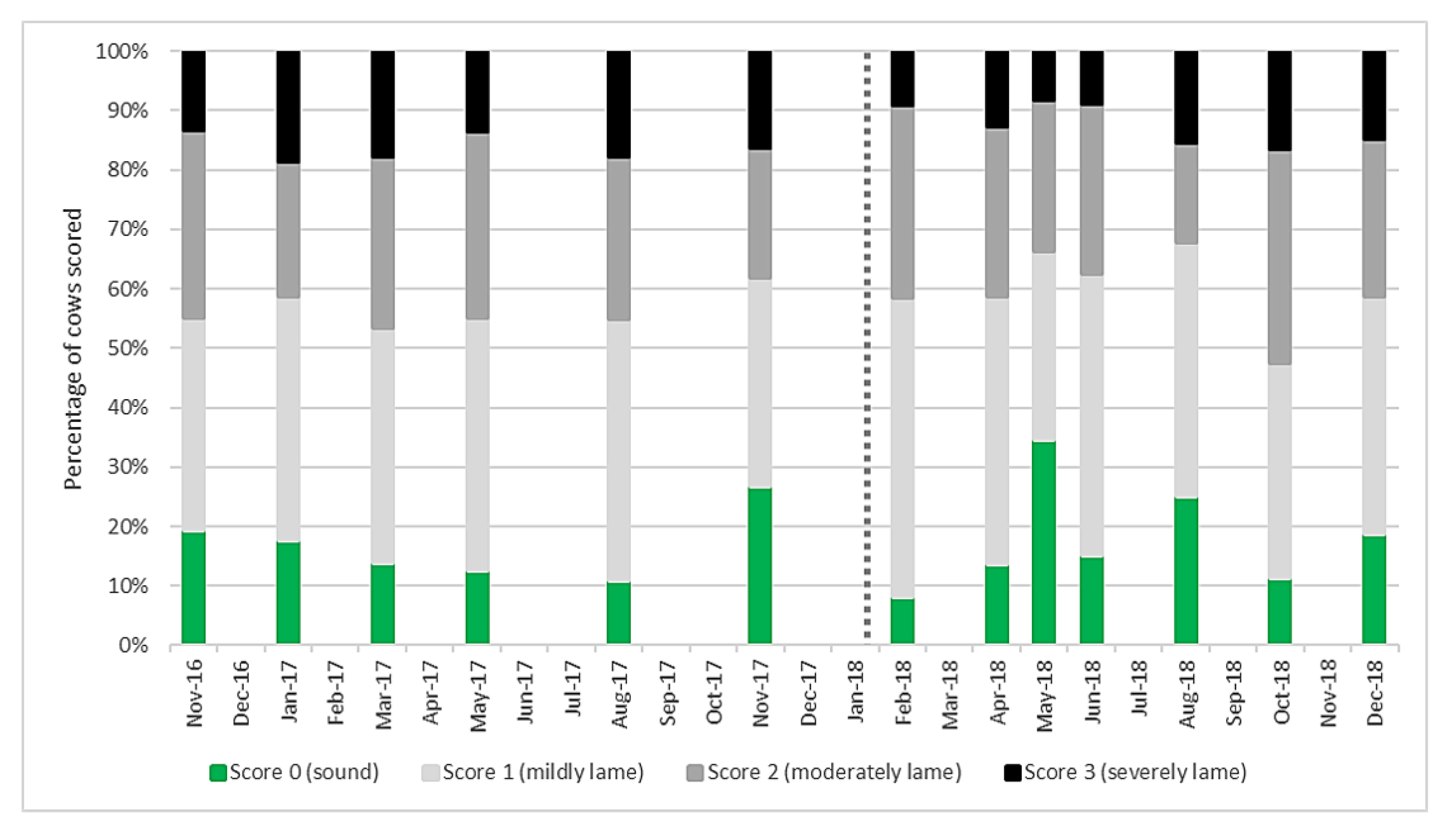
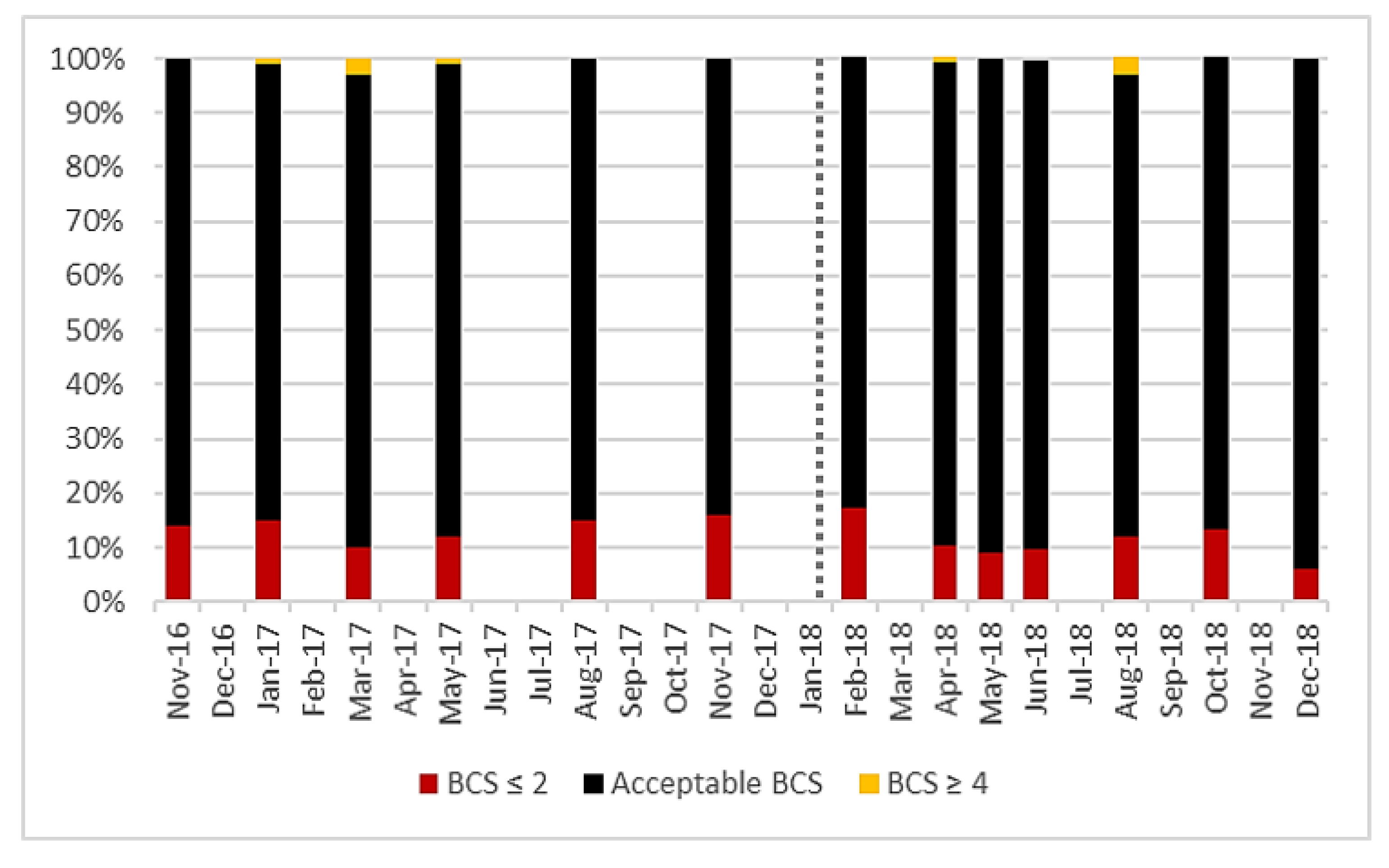
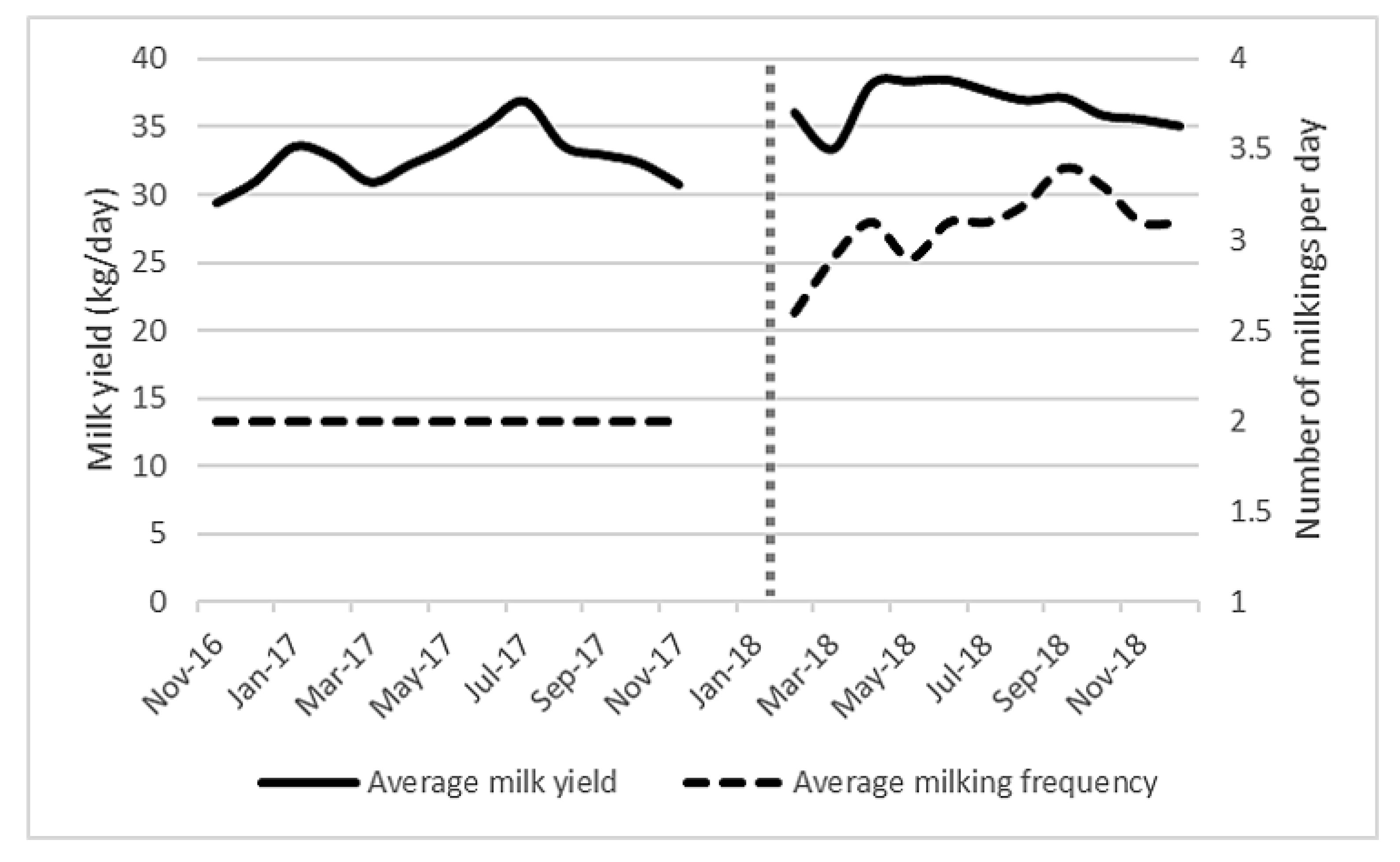

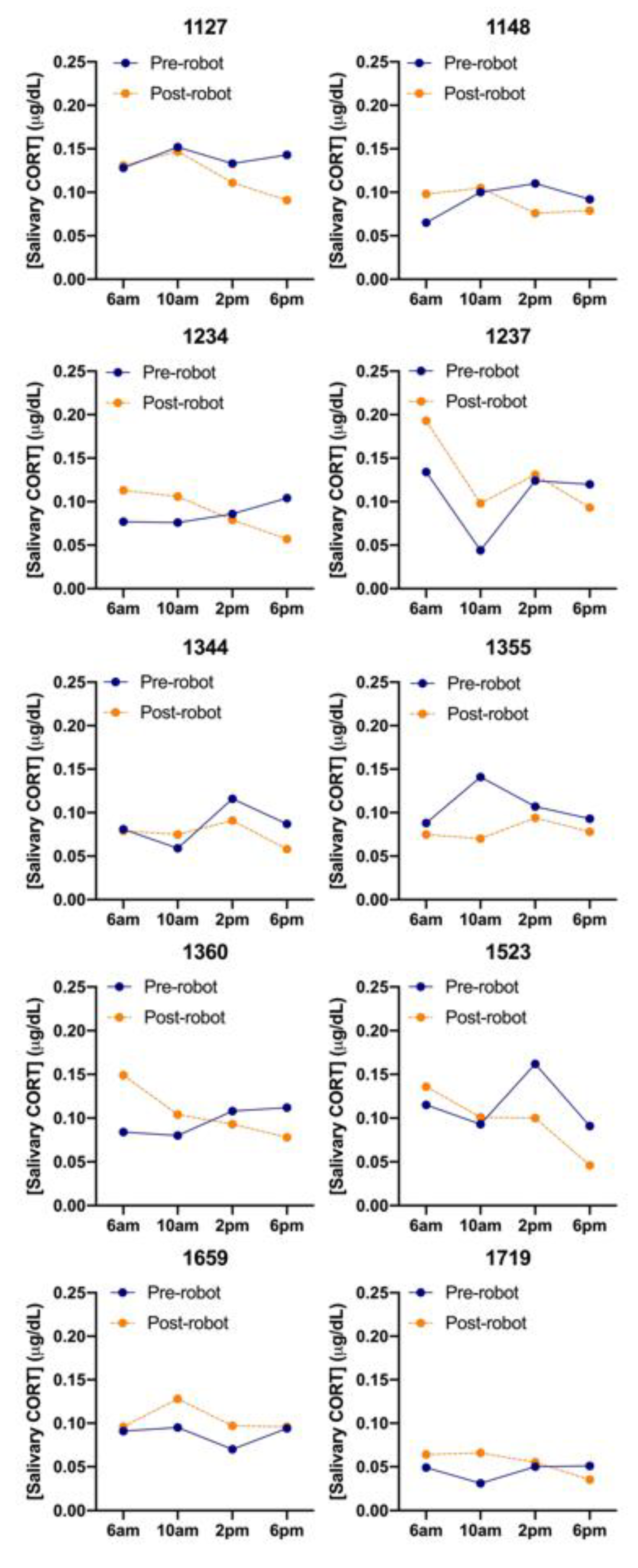
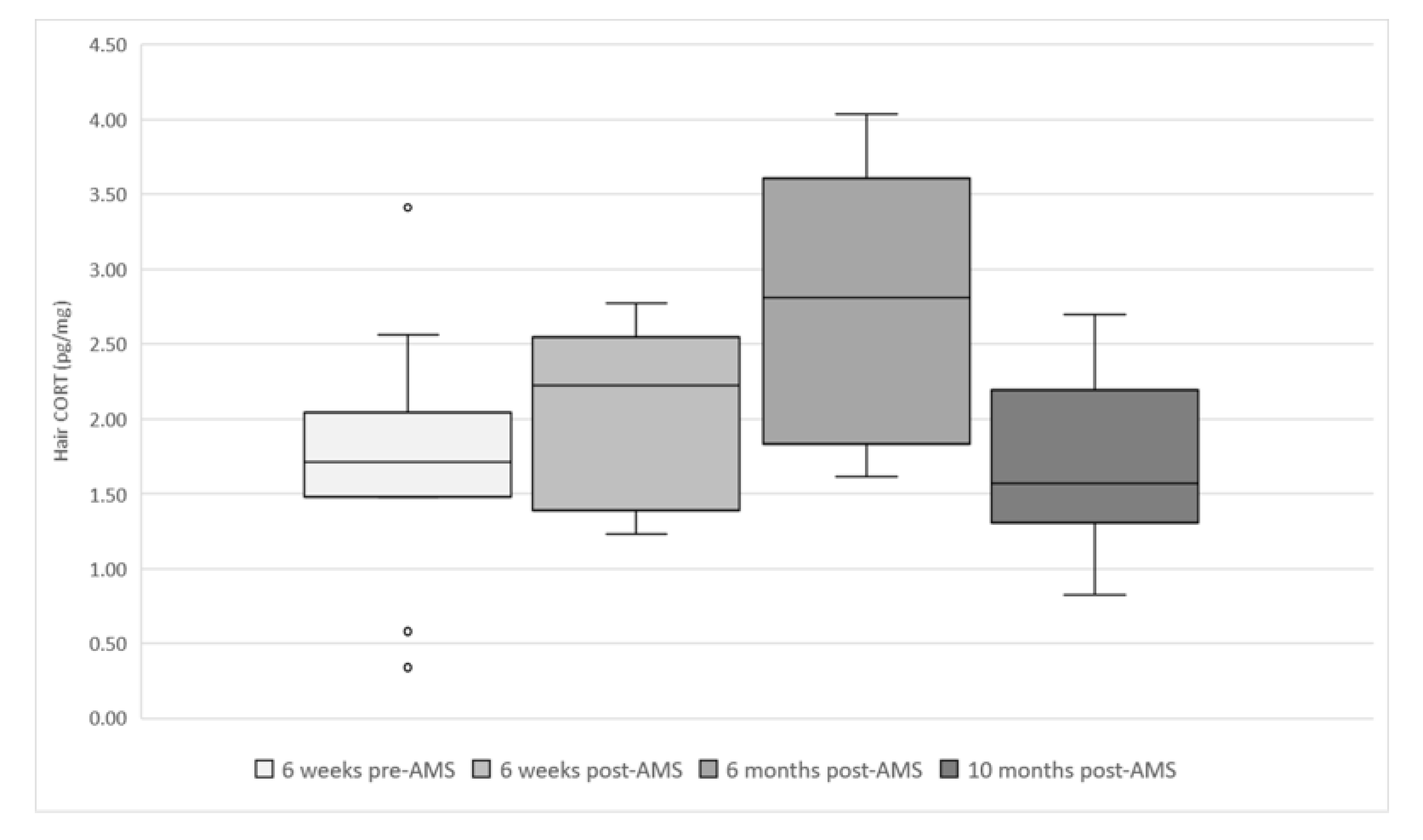
| Production Parameter | Average Daily Yield | Average Milking Frequency | Month | Average Days in Milk | Number of Cows in Milk |
|---|---|---|---|---|---|
| Average daily yield | 0.753 | 0.693 | |||
| Average milking frequency | 0.882 | ||||
| Average days in milk | −0.572 | ||||
| Average SCC | −0.366 (p = 0.033) | −0.625 | −0.486 (p = 0.006) | ||
| Lame cow percentage | 0.370 (p = 0.031) | −0.456 (p = 0.01) | |||
| Thin cow percentage | −0.331 (p = 0.049) | −0.344 (p = 0.042) |
| Saliva Cortisol (µg/dL) | Sound Cows (Score 0) | Lame Cows (Score ≥ 1) | Significance Level |
|---|---|---|---|
| Pre-AMS | 0.12704 (0.05549) | 0.08807 (0.03834) | p < 0.001 |
| Post-AMS | 0.05499 (0.01916) | 0.09863 (0.03616) | p = 0.003 |
| Significance level | p < 0.001 | p = 0.118 | p < 0.001 |
© 2020 by the authors. Licensee MDPI, Basel, Switzerland. This article is an open access article distributed under the terms and conditions of the Creative Commons Attribution (CC BY) license (http://creativecommons.org/licenses/by/4.0/).
Share and Cite
Jerram, L.J.; Van Winden, S.; Fowkes, R.C. Minimally Invasive Markers of Stress and Production Parameters in Dairy Cows before and after the Installation of a Voluntary Milking System. Animals 2020, 10, 589. https://doi.org/10.3390/ani10040589
Jerram LJ, Van Winden S, Fowkes RC. Minimally Invasive Markers of Stress and Production Parameters in Dairy Cows before and after the Installation of a Voluntary Milking System. Animals. 2020; 10(4):589. https://doi.org/10.3390/ani10040589
Chicago/Turabian StyleJerram, Lucy J., Steven Van Winden, and Robert C. Fowkes. 2020. "Minimally Invasive Markers of Stress and Production Parameters in Dairy Cows before and after the Installation of a Voluntary Milking System" Animals 10, no. 4: 589. https://doi.org/10.3390/ani10040589
APA StyleJerram, L. J., Van Winden, S., & Fowkes, R. C. (2020). Minimally Invasive Markers of Stress and Production Parameters in Dairy Cows before and after the Installation of a Voluntary Milking System. Animals, 10(4), 589. https://doi.org/10.3390/ani10040589






